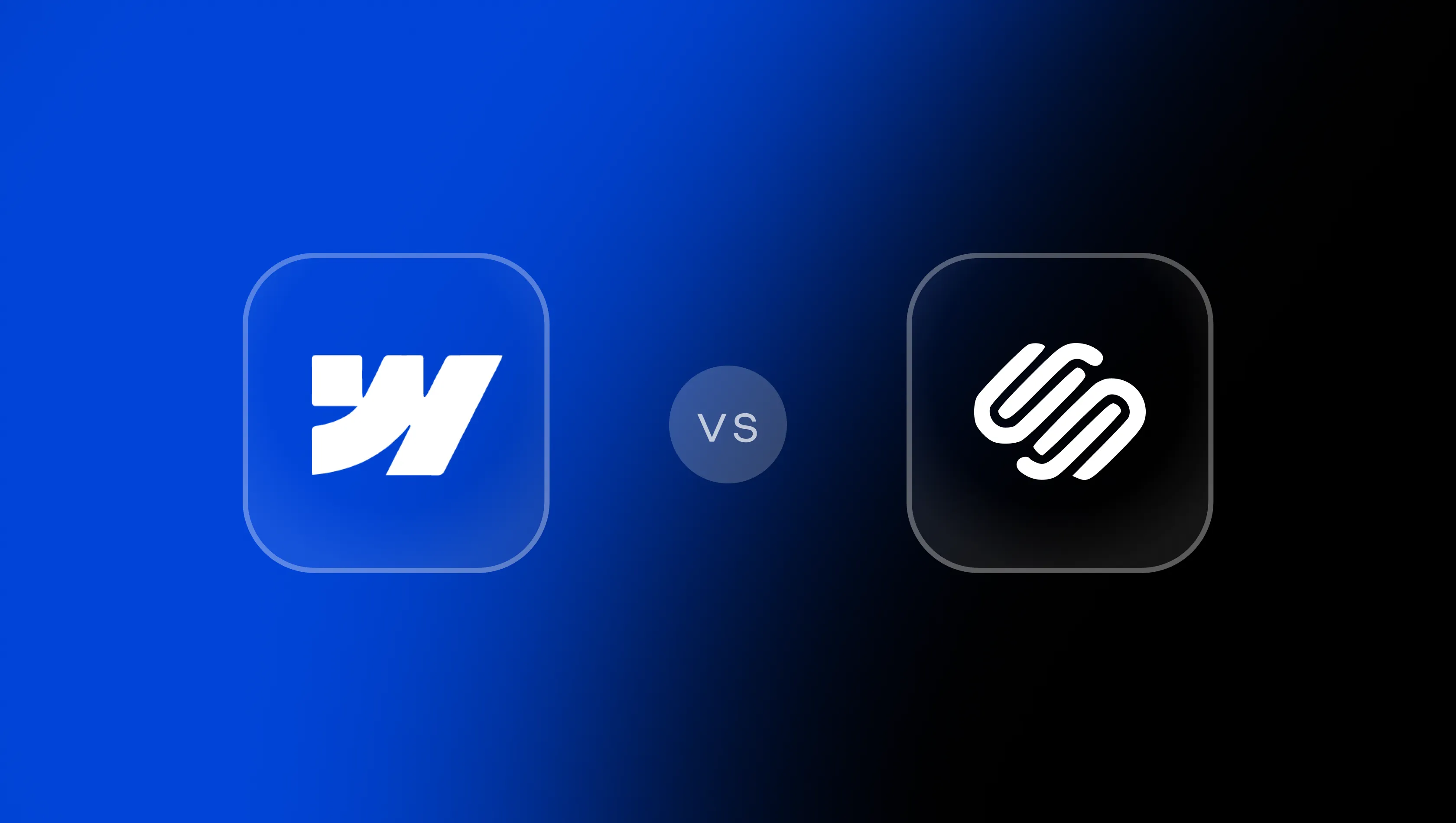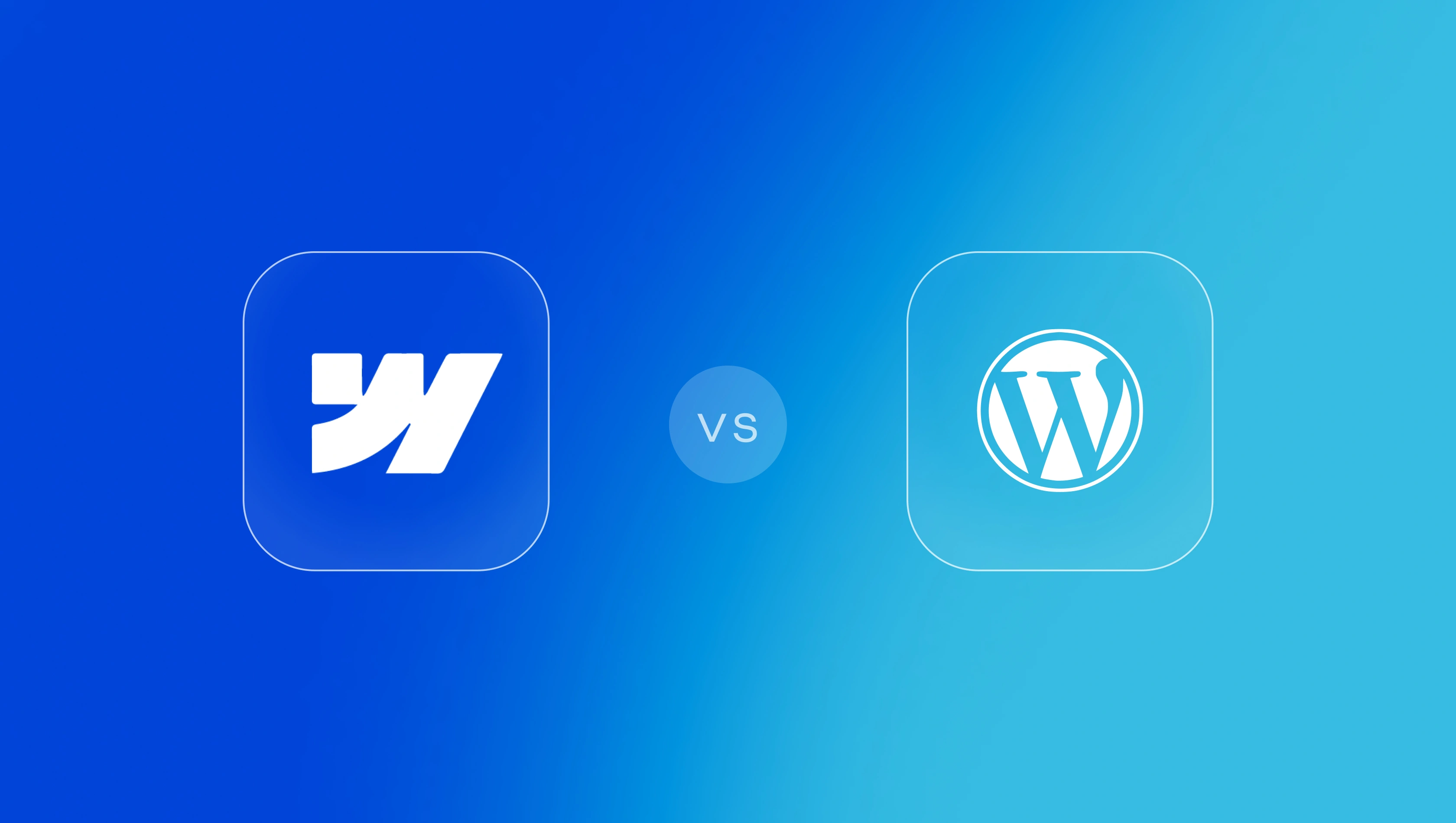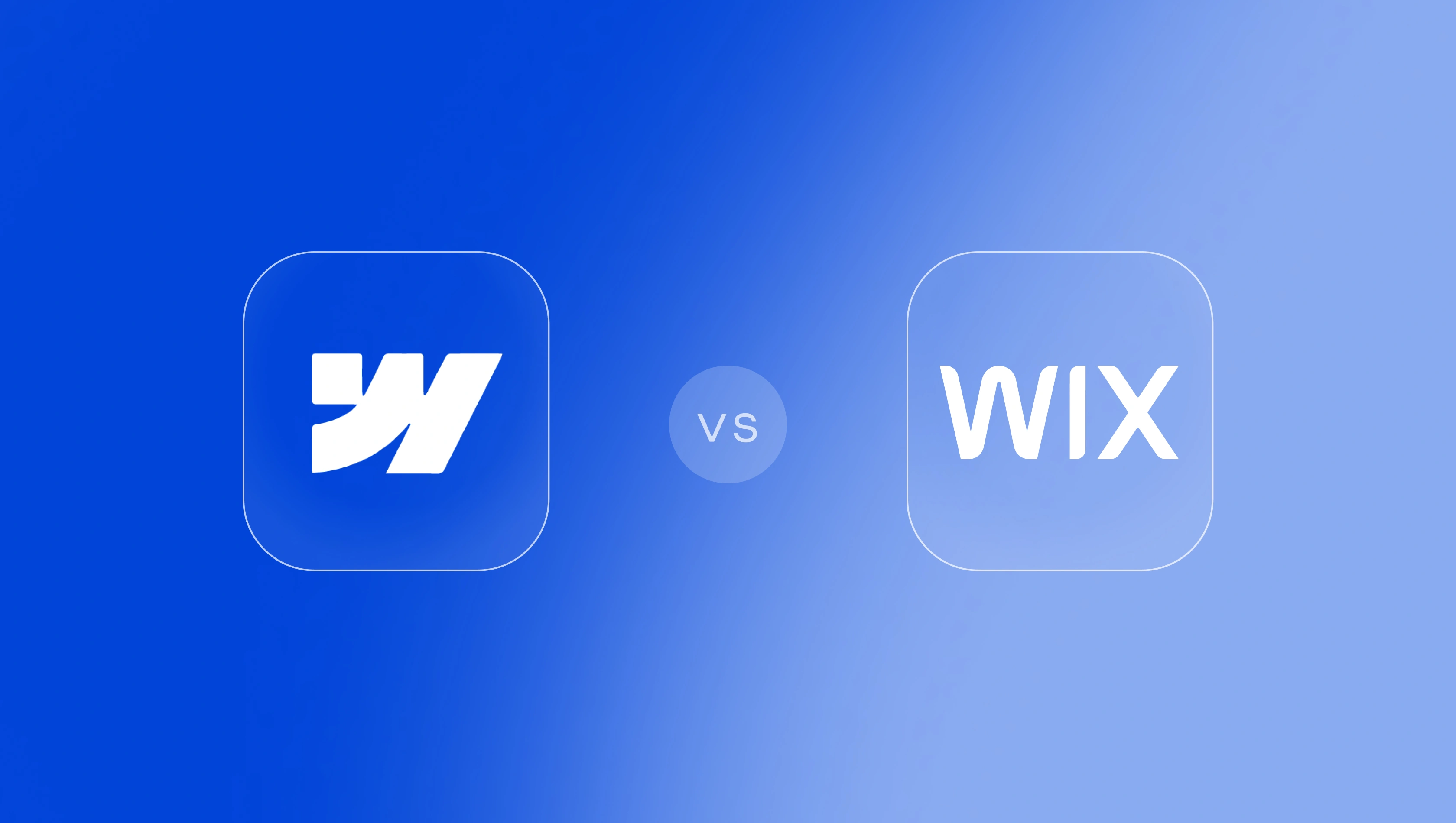Webflow vs. Squarespace: Which is Better?

Selecting the right website builder defines how a brand presents itself online. Two of the most capable options, Webflow and Squarespace, approach modern website design very differently. Webflow emphasises design precision, scalability, and control, while Squarespace focuses on guided templates, ease of use, and simplicity. This comparison explores how each platform supports ecommerce, creative teams, and everyday site management, helping businesses choose the best foundation for a flexible, long-term online presence.
What is Webflow?
Webflow is a professional no-code website builder that merges web design, development, and content management in one visual environment. It generates clean HTML, CSS, and JavaScript, ensuring consistency and scalability without relying on external plug-ins.
The platform works like a product design–style workflow workflow for marketing sites, enabling teams to design, test, and publish within the same system. Starting points such as Webflow templates or community cloneables speed up setup, but most projects evolve into fully custom websites built with complete design freedom. With flexible CMS collections and native SEO tools, Webflow provides structure, performance, and scalability in a single platform.
What is Squarespace?
Squarespace is an all-in-one website builder recognised for its elegant templates and user-friendly setup. It includes hosting, SSL, and built-in ecommerce features, allowing quick launches with minimal configuration. The guided drag-and-drop interface and structured design system make it simple for teams or individuals to create pages and maintain brand consistency.
While Squarespace offers dependable simplicity, its predefined layouts and limited customisation options can restrict creative flexibility compared with Webflow’s more open design environment.
Key Considerations
Design Flexibility
Webflow
Webflow offers extensive design freedom with pixel-accurate control over layouts, animations, and responsive behaviour. Designers can replicate brand systems and prototype interactions visually without coding. Each site’s underlying code remains clean and exportable, supporting performance and long-term maintenance. Reusable components and CMS-driven content allow teams to scale design systems efficiently across multiple pages or campaigns.
Squarespace
Squarespace offers polished templates that help users create cohesive designs quickly. Its structured editing tools ensure reliability but limit deep creative variation. Advanced customisation often requires workarounds or custom code injections. For most small to mid-sized businesses, this balance provides a consistent visual experience, though it may feel restrictive for designers accustomed to greater creative control.
Build Speed
Webflow
Webflow enables fast visual development without sacrificing structure. Designers can build, test, and publish pages directly in the platform, removing hand-offs between design and engineering. Pre-built components, Webflow templates, and visual interactions shorten production time while maintaining brand precision. The integrated CMS allows content teams to update pages instantly, ensuring that marketing campaigns can launch and adapt at pace.
Squarespace
Squarespace simplifies the setup process through ready-made templates and an intuitive drag-and-drop editor. Users can create a polished site quickly with minimal training. However, the lack of advanced layout control can make complex builds slower to refine. The platform suits straightforward launches or smaller websites that prioritise convenience over fine-tuned design detail.
SEO
Webflow
Webflow provides granular SEO tools, giving teams control over meta titles, descriptions, sitemaps, and URL structure. Each Webflow site loads efficiently thanks to clean, semantic HTML and built-in optimisation features. These capabilities make it easier to achieve strong search rankings without additional plug-ins. For marketing teams managing large or dynamic websites, Webflow’s technical transparency supports long-term visibility and adaptability.
Squarespace
Squarespace includes essential SEO features such as automated tagging, SSL certificates, and mobile responsiveness. These built-in tools handle the basics but allow limited customisation for advanced optimisation. Businesses with complex structures or multi-language sites may find the controls restrictive. Still, for smaller brands that need a dependable baseline, Squarespace offers simple, low-maintenance search performance.
Security & Maintenance
Webflow
Webflow hosting includes automatic updates, SSL certificates, and built-in security monitoring. Users don’t manage servers or plug-ins, which reduces maintenance overheads and potential vulnerabilities. Sites benefit from global CDN delivery for speed and resilience. For growing organisations, Webflow’s managed infrastructure ensures reliability without additional technical oversight.
Squarespace
Squarespace provides comparable managed security, handling all updates and SSL renewals automatically. Its closed ecosystem limits exposure to third-party risks, but it also reduces flexibility for teams wanting custom integrations. The platform suits organisations that prefer simplicity and guaranteed stability over technical configuration or version control.
Ease of Use
Webflow
Webflow takes time to learn but rewards teams with full control once mastered. Its interface mirrors design software, enabling designers to translate ideas directly into live builds. Learning to use Webflow unlocks professional-grade results without writing code, bridging the gap between design and development. While less beginner-friendly than Squarespace, it gives marketers and designers complete customisation options and faster iteration once familiar.
Squarespace
Squarespace remains the more beginner-friendly option. Its guided workflows, clear navigation, and predefined templates make page creation straightforward. Content updates, image changes, and layout tweaks can be managed without technical skills. For small teams or individuals wanting a streamlined setup, this ease of use is its key advantage, though the trade-off is reduced creative flexibility.
Website Hosting
Webflow
Webflow hosting is fully managed and optimised for performance. Sites are served through a global CDN with automatic SSL, backups, and version control. This setup removes reliance on external hosting or manual plug-ins, allowing teams to focus on content rather than infrastructure. Uptime and speed remain consistent, supporting stable delivery even under high traffic.
Squarespace
Squarespace hosting is included within every plan, simplifying setup for users who want an all-in-one service. It handles SSL and performance optimisation automatically, reducing the need for technical maintenance. While reliable, there’s little flexibility to fine-tune performance or use alternative hosting solutions. It’s ideal for smaller sites that value simplicity over configuration depth.
Scalability & Future-Proofing
Webflow
Webflow offers strong scalability through reusable design components, CMS collections, and modular structures. These features let teams expand content and pages without re-engineering layouts. For organisations planning long-term growth, Webflow provides a foundation that adapts to new campaigns, languages, and site sections while maintaining consistent design.
Squarespace
Squarespace offers dependable scalability for small to medium sites, but its structure can become restrictive as complexity grows. Adding advanced functionality or large volumes of dynamic content may require external integrations or custom code. It suits brands with stable content requirements rather than those needing continuous expansion.
Integrations
Webflow
Webflow integrates easily with CRMs, analytics, and automation tools via native connections or third-party services like Zapier and Make. These integrations allow advanced workflows such as synchronising leads, triggering campaigns, or updating content automatically. The platform’s custom code flexibility supports bespoke integrations while maintaining security and performance.
Squarespace
Squarespace includes direct integrations for commerce, scheduling, and social media, alongside built-in email marketing tools. These features simplify everyday marketing tasks but are limited compared with open integration platforms. For most small businesses, the range is sufficient, though larger teams may outgrow its capabilities as requirements expand.
Team Collaboration & Workflows
Webflow
Webflow supports collaborative workflows through workspace roles, content editing permissions, and design-stage feedback. Multiple users can work simultaneously on layouts and CMS content. Marketing teams can publish changes without developer input, reducing delays and maintaining brand control. The environment aligns with modern product and content workflows used by in-house teams and agencies.
Squarespace
Squarespace provides straightforward collaboration through shared logins and role-based permissions. While practical for small teams, the editing experience is less dynamic than Webflow’s multi-user setup. Updates often occur sequentially, which can slow iteration on large projects. It remains suitable for smaller teams where one or two people manage the site.
Content Localisation
Webflow
Webflow includes native localisation features that allow multiple languages and region-specific content within a single project. Each locale can have unique SEO settings, domains, and structure, maintaining clarity for both users and search engines. For global teams, this integration simplifies managing international sites without relying on third-party translation tools.
Squarespace
Squarespace supports localisation through manual page duplication or plug-ins, which can increase maintenance as content scales. It lacks integrated translation management, making it less efficient for multilingual sites. While suitable for single-language projects, it’s less practical for businesses operating across several regions.
Customer Support
Webflow
Webflow provides comprehensive documentation, Webflow University tutorials, and community forums alongside direct email support. These resources help users resolve both design and technical challenges efficiently. For teams seeking autonomy, the learning content significantly shortens the onboarding curve.
Squarespace
Squarespace offers 24/7 email and live-chat support with extensive help articles covering setup, templates, and ecommerce features. Its customer-care team focuses on accessibility and quick resolution, though more advanced or custom-code questions may require external resources.
Pricing
Webflow
Webflow’s pricing scales with project complexity and business requirements. Plans range from static sites to advanced CMS and ecommerce builds. Each Webflow site can include additional workspace seats or localisation features as teams expand. There’s no permanent free plan, but users can trial the platform on a limited tier before upgrading. Webflow offers transparent, flexible pricing plans that suit professional design and marketing workflows.
Squarespace
Squarespace pricing is straightforward, covering hosting, SSL, and built-in ecommerce tools under one subscription. A short free plan trial helps users explore features before choosing a tier. Packages include email marketing, analytics, and SEO tools, making it cost-effective for smaller organisations. While predictable, pricing offers less flexibility for custom or enterprise-level sites.
Enterprise Solutions
Webflow
Webflow Enterprise delivers enhanced security, scalability, and collaboration features for organisations managing high-traffic or multi-region sites. Custom SLAs, advanced permissions, and priority support ensure reliability at scale. Combined with Webflow’s CMS, it offers full control for global marketing and product teams requiring both creative freedom and operational efficiency.
Squarespace
Squarespace provides business-grade plans that include commerce, analytics, and basic role management. However, its enterprise offering is less extensive than Webflow’s, focusing on convenience over custom scalability. It remains a suitable option for small companies or content-driven sites that prioritise simplicity over system-level integration.
Webflow: Pros & Cons
Pros
Design freedom
Webflow provides precise control over layouts, animations, and responsive behaviour. Designers can replicate brand systems and prototype interactions visually without writing code.
Clean performance
The platform outputs semantic HTML, CSS, and JavaScript, improving load times and SEO visibility while maintaining scalability.
Built-in CMS
Webflow’s CMS allows teams to create and manage structured, reusable content that scales easily across campaigns and pages.
Marketing integrations
It connects seamlessly with marketing tools and automation platforms, enabling efficient content and campaign management.
Reusable components
Design systems remain consistent through reusable components and symbols, reducing build time and ensuring brand alignment.
Scalable site architecture
Webflow supports modular layouts and CMS structures that streamline updates across large websites, keeping content aligned and fast to iterate.
Native localisation
Integrated localisation tools make it easy to manage multilingual sites without external plug-ins or duplicate content.
Cons
Steeper learning curve
Beginners may find Webflow’s interface complex, requiring time to understand design structure and layout hierarchy.
Technical knowledge
Some advanced interactions and custom logic benefit from basic HTML, CSS, or JavaScript familiarity.
Limited plug-ins
Webflow has fewer one-click extensions than WordPress or Wix, though most functionality can be built natively.
Higher enterprise cost
Advanced workspace tiers and enterprise features come at a higher price than entry-level alternatives.
Squarespace: Pros & Cons
Pros
Beginner-friendly setup
Squarespace offers guided templates and a clear drag-and-drop interface, helping users publish sites quickly without technical skills.
All-in-one platform
Hosting, SSL, and ecommerce features are bundled together, reducing setup time and external dependencies.
Built-in marketing tools
Includes native email marketing, analytics, and social media integrations, ideal for small teams managing everything in one place.
Predictable pricing
Straightforward pricing plans combine hosting and updates under one subscription, keeping ongoing costs consistent.
Reliable support
Squarespace provides 24/7 support and comprehensive guides that help new users manage sites confidently.
Cons
Limited design flexibility
Users are restricted to template-based layouts, with advanced customisation requiring injected custom code.
Scalability limits
Squarespace handles small to medium sites well but becomes less efficient for large or complex builds.
Optimisation restrictions
Automated SEO features simplify setup but limit deeper optimisation for advanced marketers.
Limited integrations
Compared to Webflow, it offers fewer third-party integration options for large teams or enterprise systems.
Webflow vs Squarespace Summary
Both Webflow and Squarespace deliver strong tools for building modern websites, but they cater to different needs. Squarespace offers simplicity and dependable templates for smaller businesses wanting an all-in-one solution. Its structure and automation reduce setup time but also limit flexibility as creative or technical requirements expand.
Webflow provides the scalability and precision needed for professional teams. It combines creative control, advanced optimisation, and system-level consistency that align with long-term digital growth. For organisations seeking a design-led platform that evolves with their brand and business, Webflow offers a reliable and future-ready foundation—let’s talk.
FAQs
What makes Webflow a professional website builder?
Webflow combines web design, development, and content management in one environment that mirrors modern product workflows. Teams can build custom websites, manage structured content, and apply precise optimisation without relying on developers for each update. Clean HTML and CSS output ensures performance and long-term scalability. Compared with Squarespace vs Webflow, the difference lies in control and extensibility. Webflow scales with teams as their brand and digital requirements grow.
Is Squarespace easier to use than Webflow?
Squarespace is generally easier for beginners, with guided templates, visual editing, and automated hosting. Users can launch polished pages quickly without needing technical knowledge. Webflow takes longer to learn but rewards teams with complete design freedom, reusable components, and greater consistency for brand systems. Once mastered, teams can publish at speed without developer support, giving it an advantage for growing organisations managing frequent content updates.
Which platform performs better for SEO?
Both platforms include core SEO tools, but Webflow provides more granular control. Users can edit meta titles, descriptions, sitemaps, and semantic markup directly in the Designer, ensuring clean structure and visibility in search engines. Squarespace offers built-in SEO features that cover essentials like SSL, mobile responsiveness, and clean URLs, but they’re less flexible for advanced optimisation. For larger sites or content-led strategies, Webflow supports greater depth and transparency.
Can both platforms support ecommerce?
Yes. Squarespace includes integrated ecommerce features for small stores, with checkout, transaction fees, and inventory tools built in. It’s ideal for streamlined setups. Webflow Ecommerce offers greater design and functional control, allowing teams to create branded experiences, adjust checkout flows, and integrate with marketing tools or CRMs. While Shopify remains stronger for enterprise retail, Webflow bridges design flexibility with professional scalability for growing businesses.
How do pricing plans compare?
Squarespace pricing includes hosting, SSL, and essential tools under one monthly fee, with a short free plan trial available. Its pricing plans are predictable but less customisable. Webflow’s pricing scales with project complexity, offering flexible site plans and workspace tiers for teams. Though initial setup may cost more, Webflow offers control over performance, collaboration, and scalability, making it better suited to long-term digital growth.
Which is better for long-term growth?
Webflow supports long-term growth with modular design systems, a scalable CMS, and flexible custom code options. Teams can expand sites without rebuilding, adding pages, languages, or integrations as needed. Squarespace provides dependable stability for smaller brands but is less adaptable for evolving marketing or product strategies. For organisations expecting to scale content and complexity, Webflow offers the structure, control, and efficiency required to evolve over time.




